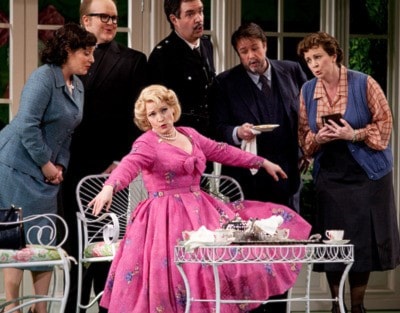A near perfect-storm of elements come together for Pacific Opera Victoria’s production (a co-production with the Vancouver Opera) of Benjamin Britten’s “Albert Herring.” It is just the right piece for still-British Victoria, mounted by and with superb talent, at an ideal time of year. In short, it is a delightful way to kick off POV’s Britten Festival, celebrating the composer’s 100th Anniversary.
Albert Herring is a chamber opera, created as a piece that could travel easily throughout a kingdom still recovering from war. There is no chorus, but an ensemble; the title character gets the only solos. Yet, the opera places technical demands on its singers and musicians. Based on a novella by Guy du Maupassant, we find ourselves in the small town of Loxford, where the resident elites — led by the meddlesome Lady Billows and her henchlady Florence Pike — seek a young woman to crown as their May Queen. All candidates are cast aside as unworthy. In a fit of inspiration, the police superintendent suggests a May King, and they settle on Albert Herring. Albert is indeed chaste and obedient, if dim, but longs to sow at least one or two wild oats, goaded by his frenemies Sid and Nancy (a delicious irony in those names, what with there being no future and all cf. Sex Pistols).
Tenor Lawrence Wilford as Albert Herring brings muscular innocence to the role, a working-class kid with a tender heart and a hidden inner-life. Wilford is able to stretch from stubborn (when defying his mother, or trying to) to loneliness and frustration (“He’s much too busy”). During scenes in which Albert is drunk, Wilford expertly balances his vocal demands with graceful slapstick movement.
Providing an emotionally authentic just-left-of-centre to the piece is Phillip Addis as Sid and Stephanie Marshall as Nancy. Young and in love, Britten doles out bright pieces to them, which they fill warmly. That being said, Britten is subtle and even Sid and Nancy’s love duets are tinged with dissonance. Addis and Marshall are technically superb.
In place of a chorus, Albert Herring has a delightful ensemble of comic parts (the town elites): Lady Billows (Sally Dibblee), Florence Pike (Susan Platts), Miss Wordsworth (Charlotte Corwin), Vicar Gedge (Peter McGillivray), Mayor Upfold (Michael Colvin) and police superintendent Budd (Giles Tomkins). Each character, ranging from bass to soprano, is unique and hilarious, as vocal style is wed to physical manner. Some difficult choral parts (structured as fugues) are deftly performed. The result is a kind of inspired cacophony. Any time this gang parades onto the stage, you have to smile.
Children were of great concern for Benjamin Britten (this is the gentleman that composed Noye’s Fludde, also part of the Britten Festival, Feb. 14 and 16, , at 7 pm, Church of St. John the Divine, 1611 Quadra), and there are three plum roles for children in Albert Herring: Emmie (Emlyn Sheeley), Cis (Cassandra Lemoine) and Harry (Ajay Parikh-Friese). Fully professional, these young performers rise to the same high standards as the rest of the cast. A fine example is the subtle difference in the way Sheeley (as Emmie) sings “Taa!” in the first act, compared to how it’s sung in the third. From playful and mischievous, to playful and near-sinister. Captivating stuff.
Leslie Dala conducts a small ensemble (each part is played by one instrument), but they sound full and robust. Many passages in Albert Herring are technically demanding. For example, a scene in the second act has Miss Wordsworth the schoolteacher try to lead a group of students in rehearsing a song to welcome the May King. The children are distracted by the food on display and this distraction, along with the excitement of the day, is communicated through the ensemble’s flautist. A flurry of notes is timed perfectly with the action on stage (much of it with the cast’s youngest performers!).
Director Glynis Leyshon decided to move the action of the opera from Edwardian England (think Downton Abbey) to the early '50s post-war (think Call the Midwife). It is a subtle difference, but an effective decision. Many members of POV’s audience would be old enough to identify with the cultural markers of the era. Leyshon’s decision to include traditional Morris Dancers is an inspired one, as it invokes ancient traditions of fertility, and adds colour and mystery to the production. Set and Costume Designer Patrick Clark created a lovely (and witty) garden backdrop (to most scenes), in the pattern of a grassy Union Jack.
Albert Herring
Feb. 15 at 8pm
Feb. 17 at 2:30pm
Royal Theatre
Tickets at 250-385-0222
or rmts.bc.ca
Review by Brent Schaus
arts@mondaymag.com
